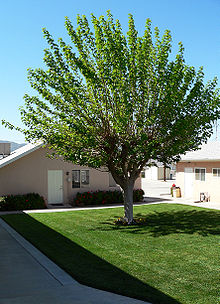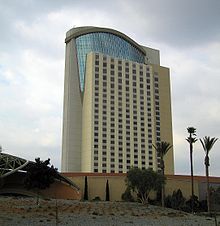- Morongo Band of Mission Indians
-
Morongo Band of
Mission IndiansTotal population 996[1] Regions with significant populations  United States (
United States ( California)
California)Languages Religion traditional tribal religion,
Christianity (Roman Catholicism)[3]Related ethnic groups The Morongo Band of Mission Indians is a federally recognized tribe. The main tribal groups are Cahuilla and Serrano. Other lineages include Cupeño and Luiseño Indians,[3]. Although many tribes in California are known as Mission Indians, some, like those at Morongo, were never a part of the Spanish Missions in California. The Morongo Reservation is located in Riverside County, California.[1]
Contents
Reservation
The Morongo Reservation is located at the base of the San Gorgonio and San Jacinto Mountains. It is over 35,000 acres (140 km2) in size. On May 15, 1876, President Ulysses S. Grant established this and eight other reservations in the area by executive order.[4] Approximately 954 of the 996 enrolled tribal members live on the reservation.[1]
Government
The Morongo Band of Mission Indians is headquartered in Banning, California. They are governed by a democratically elected tribal council. Their current administration is as follows:
- Robert Martin, Chairman
- Maurice Lyons, Vice-Chairman
- Charles Martin, Councilmember
- Elaine Mathews, Councilmember
- Dennis Miller, Councilmember
- Mary Ann Martin-Andreas, Councilmember
- Damon Sandoval, Councilmember[5]
Languages
Cahuilla and Serrano are Takic languages, part of the Uto-Aztecan language family. Cahuilla and Serrano are technically considered to be extinct as they are no longer spoken at home, and children are no longer learning them.[6]. The last speaker of Pass Cahuilla died in 2008. The last speaker of Serrano died in 2002.
Economic development
The tribe opened a small bingo hall in 1983, which became the foundation of what is now one of the oldest Native gaming enterprises in California. The government of Riverside County, California attempted to shut down the bingo hall, so the tribe joined together with the Cabazon Band of Mission Indians to fight the county all the way to the U.S. Supreme Court. On February 25, 1987, the Court upheld the right of sovereign Indian tribes to operate gaming enterprises on their reservations.[7]
The Morongo Casino, Resort, and Spa was opened in 2004[4] in Cabazon, California. It is open seven days a week, 24 hours a day. The hotel has 310 rooms. Several restaurants and bars are part of the complex, Desert Orchid: Contemporary Asian Cuisine, Potrero Canyon Buffet, Cielo: Pacific Coast Steak and Seafood Restaurant, Serrano, Sunset Bar and Grill, a food court, Mystique Lounge, and the Pit Bar. The club, 360, is open on weekends.[8]
Notable tribal members
- Marigold Linton (b. 1936), psychologist, educator, and author
Notes
- ^ a b c California Indians and Their Reservations: M. San Diego State University Library and Information Access. 2010 (retrieved 18 May 2010)
- ^ Eargle, 111
- ^ a b Pritzker, 120
- ^ a b "California v. Cabazon" Mary Ann Irwin. (retrieved 5 September 2010)
- ^ "Tribal Council." Morongo Band of Mission Indians. (retrieved 18 May 2010)
- ^ Hinton, 28, 32
- ^ California v. Cabazon Band, 480 U.S. 202 (1987).
- ^ "Morongo Casino Resort Spa." 500 Nations. (retrieved 18 May 2010)
References
- Eargle, Jr., Dolan H. California Indian Country: The Land and the People. San Francisco: Tree Company Press, 1992. ISBN 0-937401-20-X.
- Hinton, Leanne. Flutes of Fire: Essays on California Indian Languages. Berkeley: Heyday Books, 1994. ISBN 0-930588-62-2
- Pritzker, Barry M. A Native American Encyclopedia: History, Culture, and Peoples. Oxford: Oxford University Press, 2000. ISBN 978-0195138771.
External links
- Morongo Band of Mission Indians, official website
- Malki Museum, Morongo tribal museum in Banning
- The Limu Project language and cultural revitalization
Wikimedia Foundation. 2010.


